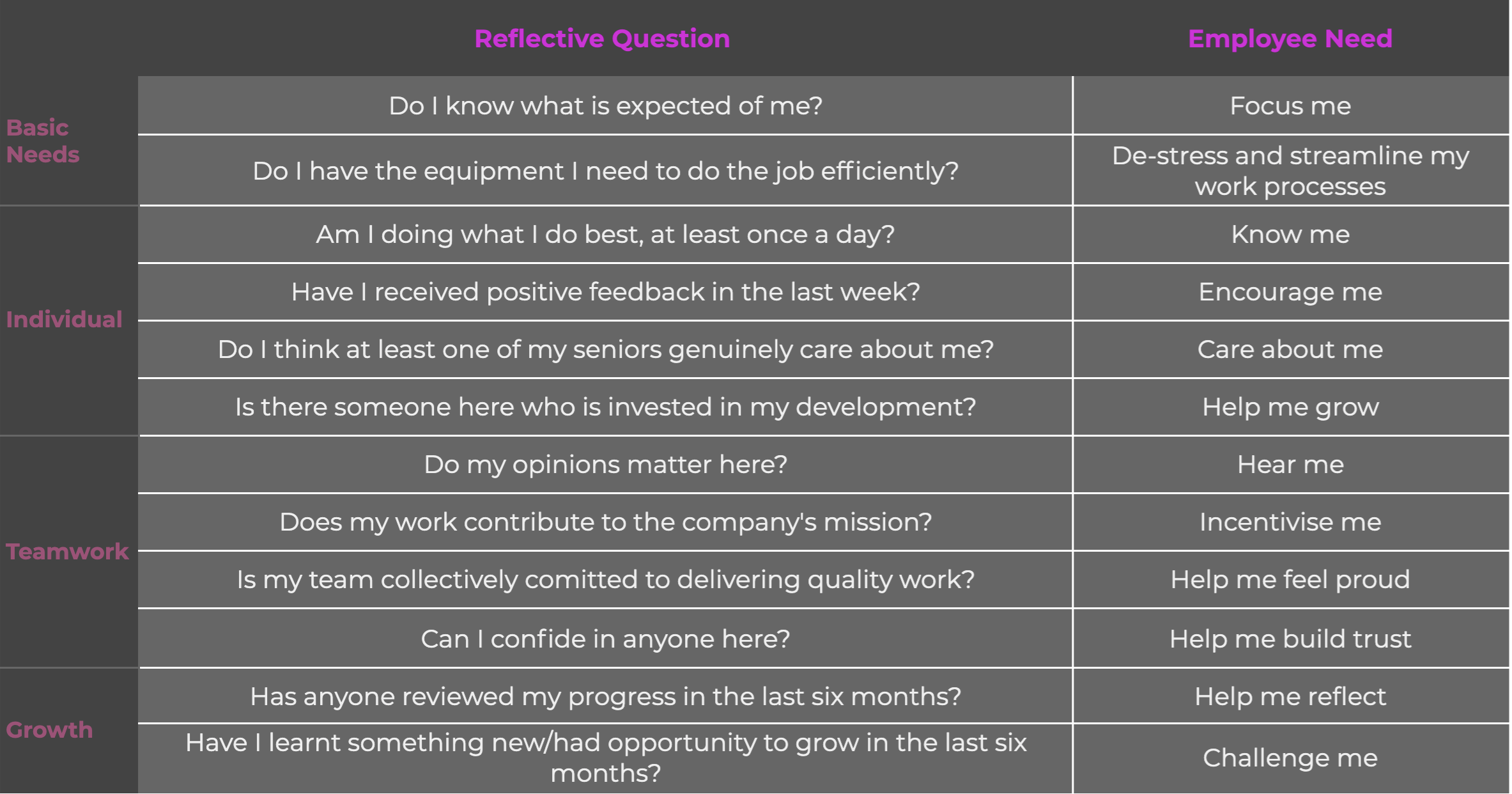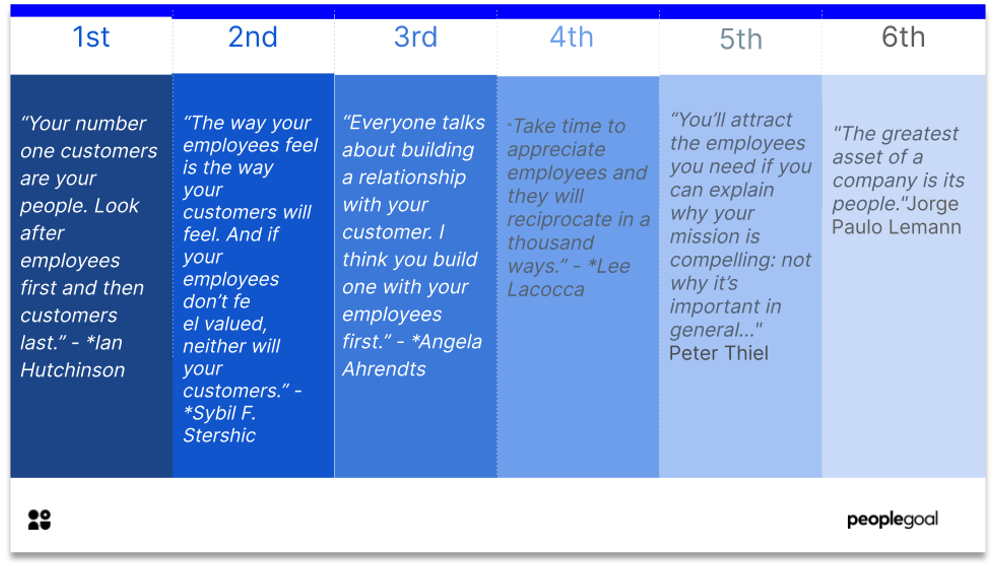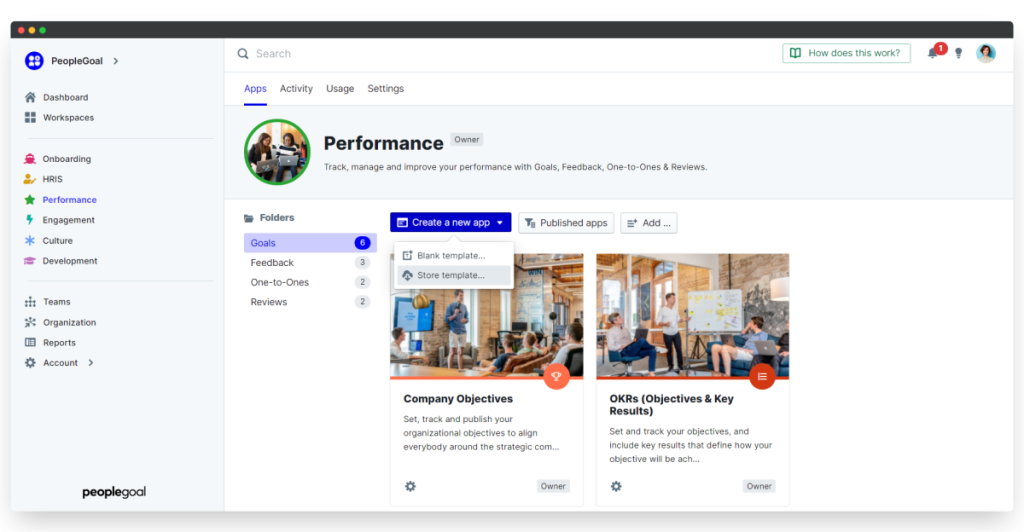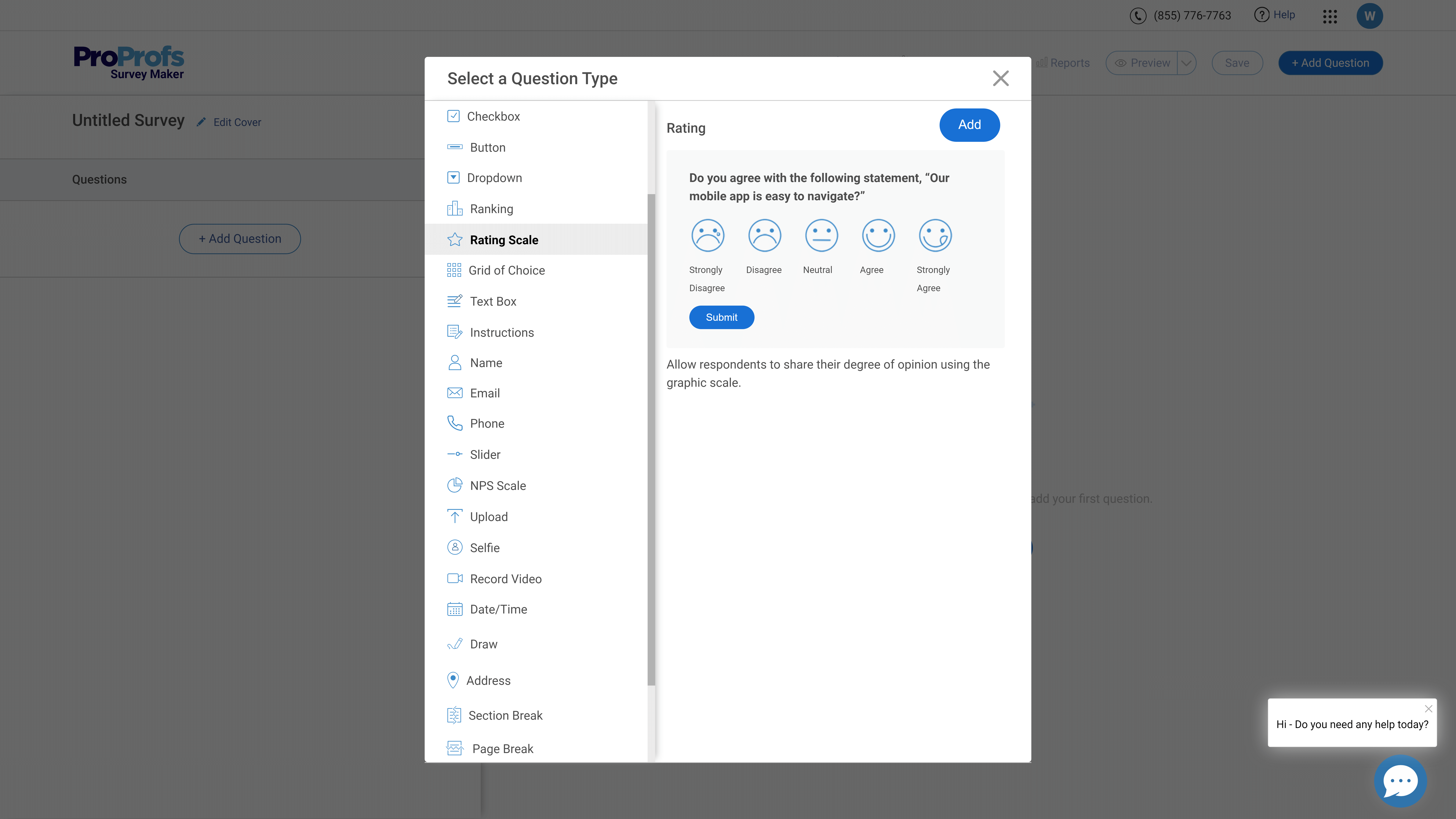One of the most valuable lessons I’ve learned while managing people is that you can’t improve what you don’t understand. And when it comes to employee engagement, assumptions are dangerous.
That’s why I rely on one of the most powerful tools in my toolkit—employee engagement surveys—a direct line for employees to share their honest opinions.
In this blog, I’m sharing the tried-and-tested employee engagement survey questions I’ve used to tap into the true voice of the workforce.
To make it easy for you, I’ve categorized these questions into various aspects of employee engagement so you can find what you need quickly.
What Is an Employee Engagement Survey?
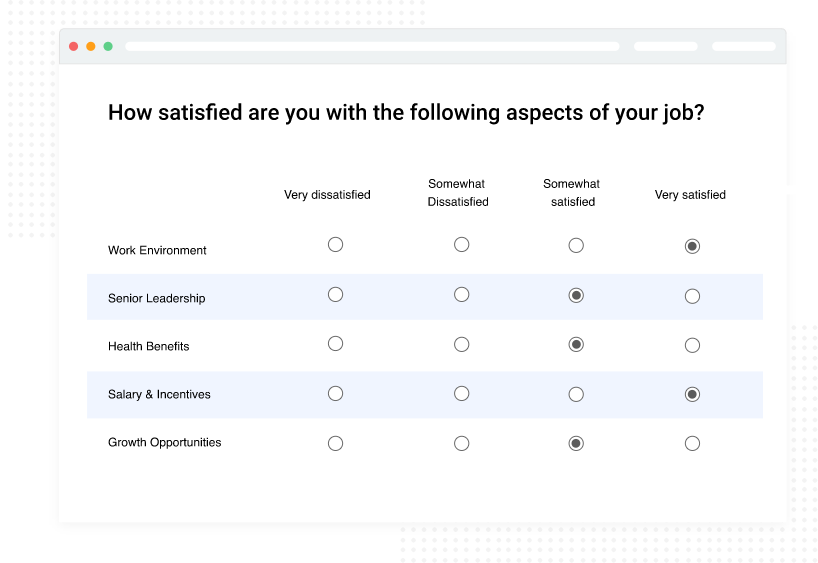
An employee engagement survey is a structured set of questions designed to measure how emotionally connected and committed employees are to their work, team, and organization. It helps uncover insights into motivation, job satisfaction, communication, leadership effectiveness, and overall workplace culture.
By regularly conducting these surveys, organizations can identify what’s working well and what needs improvement. The results of an employee engagement questionnaire can guide HR teams and leadership in making data-driven decisions to boost morale, improve retention, and create a more positive and productive work environment.

“The key element of engagement is trust; building trust requires companies to provide workers with as much autonomy and flexibility as possible.”
— Matt Charney, CMO, Recruiter.com
40+ Best Employee Engagement Survey Questions to Try Today
Your employee engagement survey doesn’t have to be one-size-fits-all. To help you choose the most relevant questions, I’ve grouped them into key categories that cover every aspect of the employee experience.
1. Job Satisfaction
- Do you feel satisfied with your current role and responsibilities?
- Is your workload manageable on a day-to-day basis?
- Do you find your work meaningful and fulfilling?
- Are you proud of the work you do here?
- Do you feel your role makes good use of your skills and abilities?
💡 Pro Tip: Look beyond the scores—analyze trends across teams or departments. If one group consistently reports low satisfaction, dig deeper to uncover the root cause.
2. Workplace Relationships
- Do you have a good working relationship with your team members?
- Do you feel supported by your immediate manager?
- Is there open and honest communication within your team?
- Are conflicts handled in a healthy and constructive way?
- Do you feel like you are treated with respect by your colleagues?
💡 Pro Tip: If responses indicate weak peer or manager relationships, consider running separate pulse surveys or focus groups to explore interpersonal dynamics further.
3. Communication & Feedback
- Do you receive regular and constructive feedback from your manager?
- Are you comfortable sharing your ideas or concerns with leadership?
- Is important information shared with you in a timely manner?
- Do you understand what is expected of you at work?
- Do leaders communicate a clear vision for the company?
💡 Pro Tip: Use open-text questions here. Employees often want to elaborate on how communication flows—or doesn’t—within the team or organization.
4. Career Growth & Development
- Do you have opportunities to grow professionally within the company?
- Is there a clear path for advancement in your career?
- Have you had access to training or learning programs in the past 6 months?
- Do you feel encouraged to develop new skills?
- Does your manager support your career development goals?
💡 Pro Tip: Pair survey feedback with learning & development metrics. For example, if employees feel stagnant, audit whether training opportunities are accessible and aligned with their roles.
5. Recognition & Rewards
- Do you feel recognized for your contributions at work?
- Are you satisfied with the recognition you receive?
- Do team members appreciate each other’s efforts?
- Does leadership acknowledge good performance?
- Are rewards and promotions handled fairly?
💡 Pro Tip: Recognition isn’t one-size-fits-all. Use survey feedback to identify how different teams or individuals prefer to be recognized—publicly, privately, with rewards, or just words.
6. Work-Life Balance
- Do you feel you have a healthy balance between work and personal life?
- Can you disconnect from work during your time off?
- Are flexible working arrangements available to you?
- Do you feel supported when dealing with personal or family issues?
- Is stress at work manageable?
💡 Pro Tip: Look for mismatches between roles. If some departments report poor work-life balance while others are thriving, consider role-based flexibility or workload redistribution.
7. Organizational Alignment
- Do you understand the company’s mission and values?
- Do you feel your work contributes to the company’s goals?
- Are you confident in the direction the company is heading?
- Do you trust the decisions made by senior leadership?
- Do you believe the organization is socially responsible?
💡 Pro Tip: Low scores here could signal unclear company vision or lack of transparency from leadership. Follow up with all-hands meetings or internal comms to realign and reinforce goals.
8. Inclusion & Belonging
- Do you feel a sense of belonging at work?
- Is your team inclusive of people from all backgrounds?
- Can you be your authentic self at work?
- Does the organization actively promote diversity and inclusion?
- Do you feel safe expressing your ideas and opinions?
💡 Pro Tip: Ensure high anonymity for this section. Employees may hesitate to share their true feelings about inclusion unless they feel completely safe doing so.
9. Engagement & Motivation
- Are you motivated to do your best work every day?
- Do you feel excited about coming to work?
- Would you recommend this company as a great place to work?
- Do you feel committed to the organization’s success?
- Are you likely to be working here a year from now?
💡 Pro Tip: Use this section to track early warning signs. Declining motivation often precedes burnout or attrition—act fast with one-on-ones or manager check-ins.
Best Practices for Creating Employee Engagement Surveys
Before you hit ‘send’ on your next survey, there are a few points I want you to keep in mind. Over the years, I’ve gathered insights—not just from fellow HR professionals, but also from employees themselves.
These lessons can help you avoid common pitfalls and get the most value from your survey results.
1. Learnings From Employers/HR Reps
- Avoid survey fatigue—it’s real. Early on, I made the mistake of launching too many surveys, too close together. Participation dropped, and so did the quality of responses. Employees felt overwhelmed, not engaged. Now, I focus on quality over quantity—timed surveys with a clear purpose and enough breathing room between them.
- Remote teams can’t be an afterthought. In the early days of hybrid work, I focused heavily on in-office culture—completely overlooking our remote employees. Now, I make sure our surveys include remote-specific touchpoints—like communication tools, inclusion in meetings, and access to resources—so every voice is equally heard.
👉Check Out: Top 10 New Employee Forms for Remote Hires
- Don’t ask what you can’t act on. There was a time I included questions like “Would you prefer a 4-day workweek?”—even though I knew leadership wasn’t open to that change. That backfired. It raised false hopes and created frustration. I’ve learned to only ask engagement survey questions where we’re genuinely open to feedback or change.
- Always, always follow up. There was a time we launched a survey, got great feedback… and then did nothing with it. Huge mistake. Employees noticed—and trust took a hit. Now, we close the loop with a “You said, we did” approach. It shows we’re listening and are serious about our employee engagement survey communications.
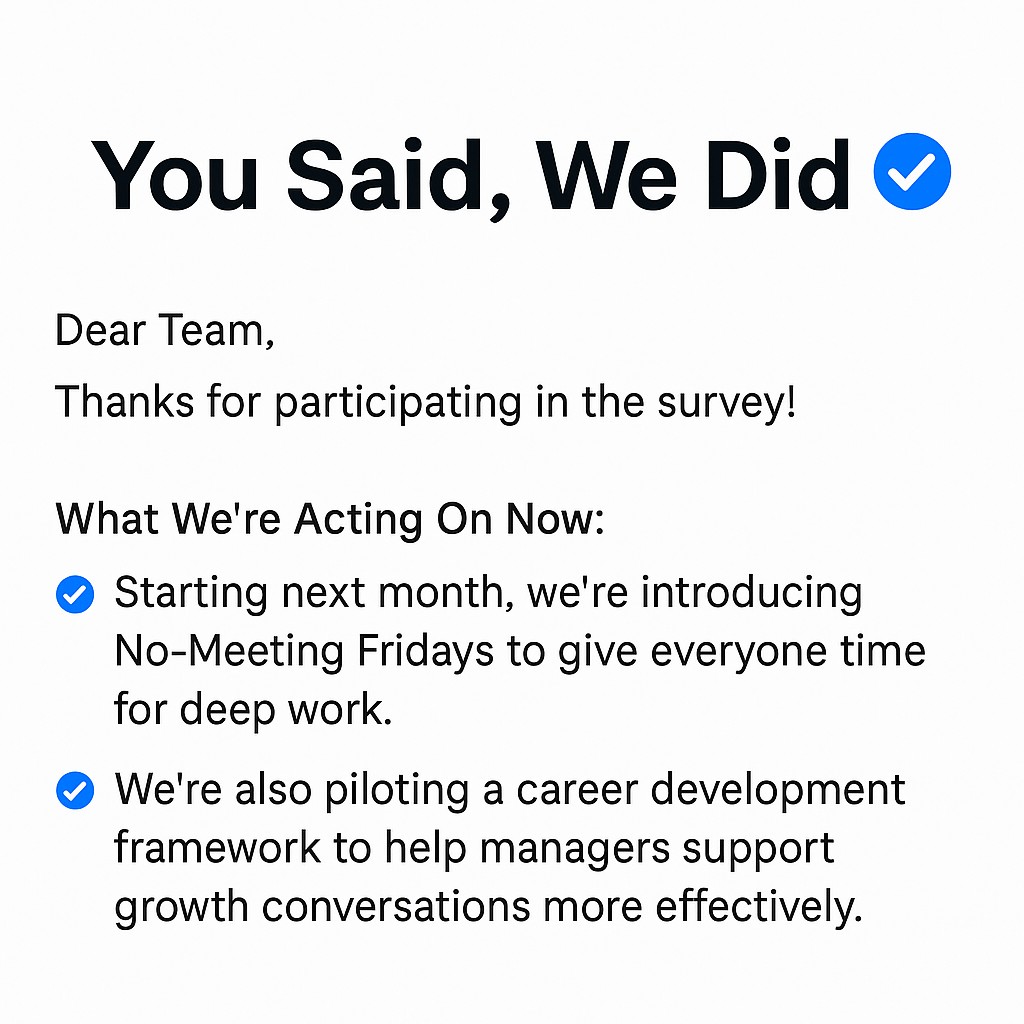
2. Learnings From Employees
- Employees want more than a rating scale. I’ve had employees tell me, “I wish there was space to explain why I gave that score.” That was eye-opening. People don’t just want to tick boxes—they want to be heard. Since then, I’ve added open-text fields next to key questions. The stories we get are where the gold really is.
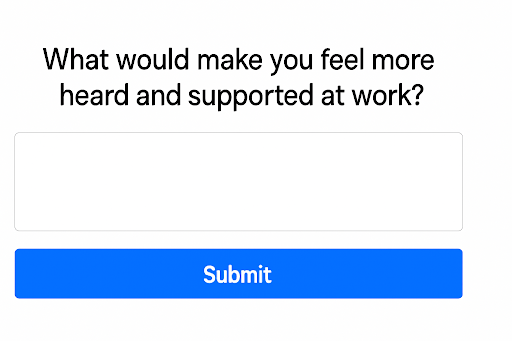
- They fear being held accountable. I’ve learned the hard way that if there’s even a hint of traceability, people will hold back. One team member once asked if their manager could “see what I wrote.” That shook me. Now, I make it crystal clear what’s anonymous—and we use third-party tools to back that up.
- Tone matters more than you think. I once used the phrase “rate your performance” in a question. Guess what? It sounded like a test—and people hated it. A simple change to “How confident do you feel in your role?” made all the difference. I’ve learned that empathetic, conversational wording makes surveys feel safer and more inviting.
- They notice when you ignore the results. More than once, employees have told me, “We gave feedback… and then nothing changed.” That kind of silence can kill engagement faster than a bad boss. Now, even if we can’t implement everything, we communicate what we can do—and why. Transparency builds trust, even when change is slow.
How to Create an “Anonymous” Employee Engagement Survey
When I set out to create an employee engagement survey, anonymity was my top priority. I wanted honest feedback—not just what employees thought I wanted to hear. That’s where PeopleGoal came in handy.
With its intuitive interface and built-in anonymity settings, I was able to build a survey that felt safe and confidential for everyone involved.
Here’s a short video you can watch to create your first engagement survey today:
Otherwise, follow the instructions below.
1. Choose or create a workspace
Once you’re logged into PeopleGoal, from the left-hand menu, select an existing workspace or create a new one where your survey will be stored.
2. Hover over to the ‘Engagement’ section and click ‘Browse Templates’
Explore ready-made employee engagement survey templates designed specifically for employee engagement.
3. Select a template and click ‘Add to Account’
Find the template that fits your needs best and add it to your chosen workspace.
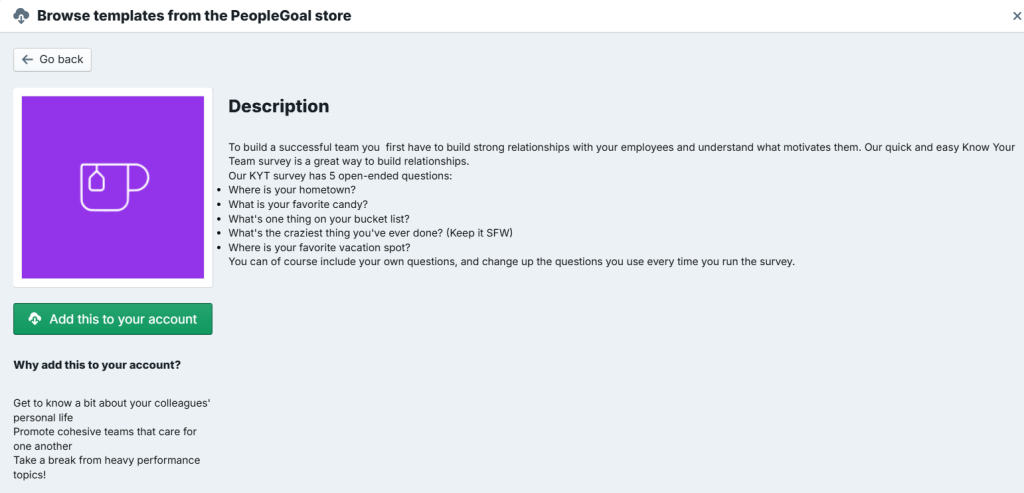
4. Click ‘Template’ then ‘Edit Template’ to customize the survey
The template will be organized into categories like:
- Manager/supervisor relationships
- Teamwork
- Growth opportunities
- Work-life balance
- Communication
- Behavioral fairness
- Employer Net Promoter Score (eNPS)
Click into each section to edit, duplicate, or remove questions as needed.
5. Add or rearrange form elements
Drag and drop questions to rearrange them. To add a new one, scroll to the bottom of the template and click the blue “+” icon.
You can choose from over 30 field types including multiple choice, rating scales, text fields, and more.
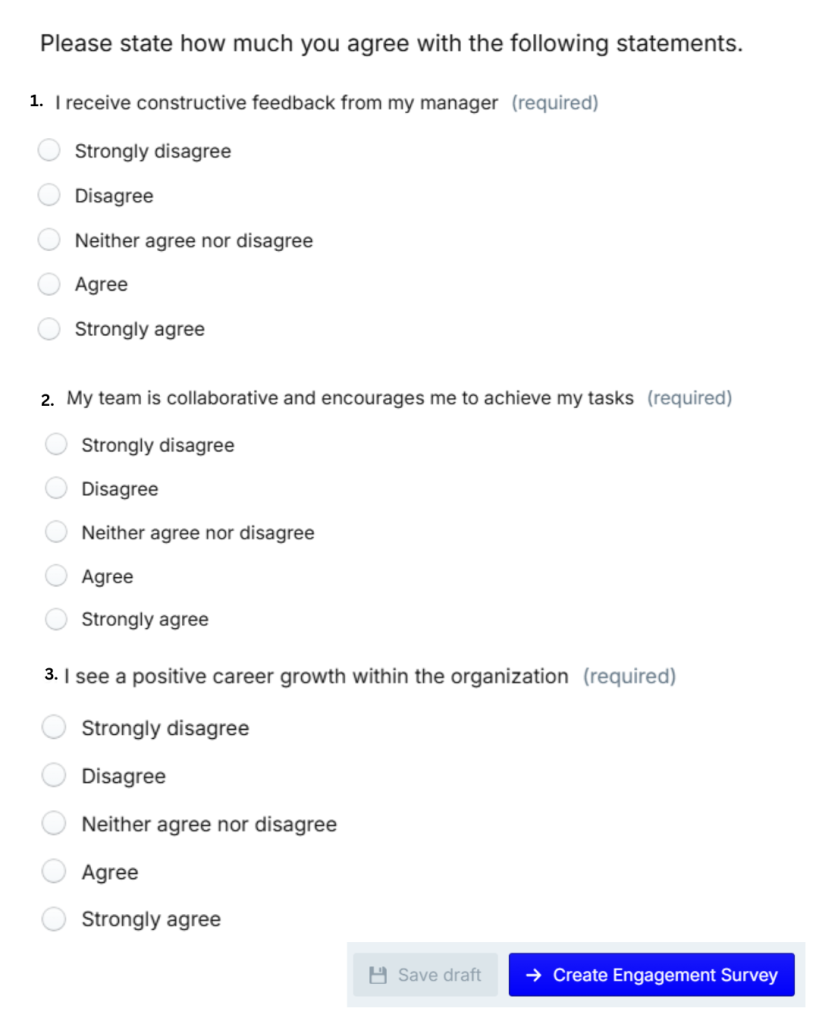
6. Choose between anonymous or named responses
For anonymous responses:
- Go to Settings
- Enable Web Form
- Toggle on “Anonymous responses only”
This generates a survey link that doesn’t require employees to sign in.
For named responses:
- Click New Engagement Survey
- Select individual users or teams to send the survey directly.
7. Adjust permissions (optional)
Use the Permissions tab to control who can access the app and view survey results.
8. Share the survey
For anonymous surveys, copy the Web Form link and share it via email, Slack, or any internal channel.
For named surveys, the platform handles the distribution automatically.
9. Analyze the results
Once responses start coming in:
- Go to the Data tab
- Click New Report and Save as Template
- Use the Chart feature to visualize results with radar charts, bar graphs, or other formats.
Group data by response category to easily spot trends and areas for improvement.
That’s it! A few clicks and a bit of customization are all it takes to run a professional engagement survey that helps you truly understand how your team is feeling.
Effectiveness of Specific Question Types
Here is a list of employee engagement survey questions that users generally perceive as effective or ineffective.
| Question Type | Example Question | Effectiveness | Why it Works/Doesn’t Work? |
|---|---|---|---|
| Specific and Actionable Questions | Do you have the materials and equipment to do your work right? | Effective | Provides concrete data that can be used to identify and address specific issues within the organization. Low scores clearly indicate areas needing improvement. |
| Well-Designed Open-Ended Questions | What's one frustration you have at work that you believe your manager has the authority to fix immediately? | Effective | Can provide rich qualitative data and uncover underlying frustrations, suggestions, or insights that closed-ended questions might miss. It should be specific and probing to avoid vague responses. |
| Manager Support & Communication | Do you regularly receive constructive performance feedback from your manager? | Effective | Given the significant impact of managers on employee engagement, questions assessing the quality of manager-employee relationships, feedback, and support are considered crucial for understanding and improving the employee experience. |
| Alignment with Mission & Values | Does the company's vision and values inspire you? | Effective | Gauge how connected employees feel to the organization's overarching goals, strategy, and values. Employees who feel aligned are more likely to be engaged and committed. |
| Vague and Broad Questions | How satisfied or dissatisfied are you with the company culture? | Ineffective | Yield ambiguous responses that are difficult to interpret and act upon. Do not provide specific insights into areas needing improvement. |
| Leading or Biased Questions | What do you think of our new fantastic development scheme? | Ineffective | Steer respondents towards a particular answer, preventing the capture of genuine feedback and skewing survey results. |
| Double-Barreled Questions | Do you feel your manager communicates effectively and supports your career development? | Ineffective | Ask about two different things at once, making it difficult for respondents to provide clear and accurate answers. It's unclear which aspect of the question the response refers to. |
| Pay (if no intention to change) | Are you paid well enough?" (in a context where pay is not being reviewed) | Ineffective | Asking about salary satisfaction when the company has no plans to adjust compensation can create frustration, resentment, and false expectations among employees. |
| Lacking Clear Path to Action | I have confidence in this company's leaders." (without further specification) | Ineffective | Questions where a low score doesn't provide clear guidance on what specific actions the company should take to address the issue. Often includes vague terms like "trust" or "confidence" without specifying the context. |
➡️Next Steps: Measure Employee Engagement Today!
“Happy and engaged employees lead to happier customers.” – A successful CEO
Measuring employee engagement isn’t just a one-time activity—it’s an ongoing conversation. When you ask the right survey questions for employee engagement and truly listen to the answers, you gain valuable insights into what drives motivation, satisfaction, and retention in your workplace.
That’s where a tool like PeopleGoal comes in. From building customizable, anonymous engagement surveys to tracking employee performance and development, it offers everything you need in one powerful platform. Whether you’re rolling out your first survey or refining a mature engagement strategy, PeopleGoal makes it easy to measure what matters and act on what you learn.
Ready to 3x Your Teams' Performance?
Use the best performance management software to align goals, track progress, and boost employee engagement.

